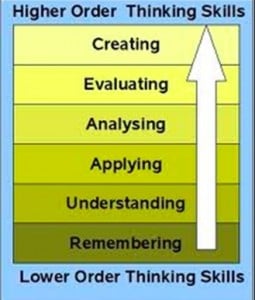How many of us have said “Today I want you to Google……..”, and sent students off to research a topic. It is vital that we ensure that students know how to assess the authenticity of websites and sources. The internet allows anyone to be an expert, but what expertise can be trusted to be authentic??
I think that this has to be more than telling students they need to be wary of Wikipedia (which I believe is a great tool and can be used as a starting point before the ideas can  be explored on other sites). We need to think about the underlying skills we need to be teaching, so that these skills become lifelong skills. We need to teach our students to become critical consumers of information.
be explored on other sites). We need to think about the underlying skills we need to be teaching, so that these skills become lifelong skills. We need to teach our students to become critical consumers of information.
There is no ‘neutral’ text, all texts have been created with some bias even if that bias is not intentional. Take this text (blog post) for example I am not neutrally writing this, I am using this text to try to persuade my readers that it is important to teach students to be critical learners. If we look at popular symbols we see everyday they are trying to convey a message to us as consumers (The McDonalds symbol for instance has been created to convey a certain message).
 If we think about these skills in terms of blooms taxonomy, skills such as evaluate and analyse are complex thinking skills, and so can not be taught through just one lesson, but this is an ongoing process. We need then to ensure that we start by teaching students about the vocabulary you will be using, what does trustworthy mean? what does reliable mean? what so different domain names mean? etc .
If we think about these skills in terms of blooms taxonomy, skills such as evaluate and analyse are complex thinking skills, and so can not be taught through just one lesson, but this is an ongoing process. We need then to ensure that we start by teaching students about the vocabulary you will be using, what does trustworthy mean? what does reliable mean? what so different domain names mean? etc .
Then moving up to understanding ensuring that students understand what this looks like. What does a trustworthy website look like? What would I be looking for?
next, ensuring that the students then get a chance to apply that knowledge through modelled practice (the teacher modelling what she would looking for), shared practice (where the teacher and the class do it together) and then onto independent practice of applying those concepts.
As we move up looking at analysis and evaluating, students start implementing the skills and concepts  they have learnt and apply these to everyday practices.
they have learnt and apply these to everyday practices.
There are various websites you can use with your students to help teach and learn about these concepts. The websites listed below are all ‘FAKE’. They provide a good starting point to start unpacking some of the concepts we could look at in terms of information creditability. Before moving on to compare and contrast authentic ones. (ensure that you look at each of these websites first to ensure there suitability for your age group).
Dihydrogen Monoxide Research Division
The general delivery university
So what sorts of things can you look for
1. Who is the author – what are there qualifications? Do they have expertise in this area?
2. What is the authors purpose? – Is it to inform, persuade, entertain
3. What is the domain name? – this can tell you a lot about the author and also the purpose of the website
4. What is the date? how old is the information? Is the information still relevant?
5. Is there online advertising? – sometimes when there is advertising which id not related to the site it can give you an indication as to the type of site.
6. Can the information be verified? – can you find the information on another site?
I have created an info-graphic you can download and print out to hang up and use in the classroom.
You can download the infographic here
Some References:
Flanagin, A. J., & Metzger, M. J. (2007). The role of site features, user attributes, and information verification behaviors on the perceived credibility of web-based information. New Media & Society, 9(2), 319-342.
Menchen ‐ Trevino, E. & Hargittai, E. (2011). Young Adults’ Credibility Assessment of Wikipedia. Information, Communication and Society . 14 (1):24 ‐ 51.
Vasquez, V. (2012). Technology and critical literacy in early childhood. New York, NY: Routledge.

